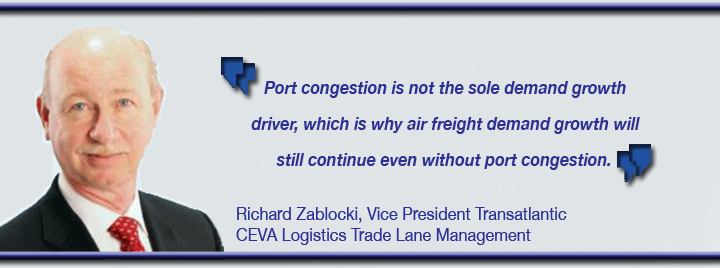
The U.S. West Coast slowdown
continued to benefit the air cargo sector through the first quarter, with
cargo moving in increasingly diverse routings from Asia to the U.S. as
logisticians, airlines, and shippers adapted to a fast-changing market,
according to one leading forwarder.
Richard Zablocki, vice president of CEVA
Logistics Trade Lane Management division with responsibility for the Transatlantic
market, told FlyingTypers that first quarter demand for airfreight
was exceptional and peaked in the mid to third week of March.
 |
“That has to be largely attributable
to the U.S. West Coast port slowdown driving more air exports out of Asia
for the Transpacific,” he added.
“We saw Asia Pacific freight flow
for North America by way of Europe as an alternative routing causing peaking
conditions out of the major airports for a short period of time.”
He said the port situation was now improving
and air volumes had slowed on the Transpacific, but he still predicted
growth in demand for the year—albeit at a slower pace compared to
the first quarter—due to positive economic confidence and consumption
reports out of Europe and North America.
“CEVA is projecting better than market
growth expectations for some of these regions, and the global market to
grow by some 3.6-4.0 percent year-on-year in 2015,” he added.
“Port congestion is not the sole demand
growth driver, which is why air freight demand growth will still continue
even without port congestion.”
However, a tailing off of peak demand has
now seen rates soften. “While we prefer not to speculate about rates
we do see that—with the decline in demand out of the AP’s
major ports at the end of March and the beginning of April—peak
rates have dropped as would be expected,” said Zablocki.
On the supply side, the market could be
thrown off balance by low fuel prices and the healthy passenger demand
environment, which could lead to a significant increase in air freight
capacity.
“However,” he noted, “in
February demand grew by 11.7 percent according to IATA, whereas air freight
supply in ATK only grew by 4 percent year-on-year based on Seabury figures.
“The freighter share increased only
slightly from 37.1 percent in January 2015 to 37.3 percent in February
and fell back to 37.0 percent in March.
“For the full year 2015, we expect
an increase in capacity of around +7.5 percent, of which the majority
of that growth results from massive belly capacity injection from Asia
Pacific carriers.”
Ceva is now boosting its own service portfolio
to better serve the needs of its air freight forwarding customers. The
company will launch a Sea-Air product between Asia and Europe in 2015
combining the advantages of cost-efficient ocean and fast air freight
transportation. Ceva will also roll out Cargo2000 implementation around
Q3 2015.
Moving forward, Zablocki expects China to
generate some of the most positive growth rates by lanes. He forecasts
Germany-China eastbound and westbound to expand by 7.7 percent and 5.6
percent this year, respectively. China to South Korea is expected to see
growth rates of 6.0 percent eastbound and 7.3 percent westbound, while
China-Saudi Arabia and China-UAE westbound are expected to expand by 11.9
percent and 9.1 percent, respectively.
Other interesting air freight trades in
2015 will be Vietnam exports, imports to the Netherlands, and China-Latin
America, where the emphasis will be on that region’s logistics and
manufacturing powerhouses, Brazil and Mexico.
Turning to intra-Asia air freight demand,
he said this increased slightly above average in 2014 at +4.8 percent
compared to global market expansion of +4.5 percent, despite the big China
export lanes to Japan (+1.1 percent), South Korea (+1.5 percent) and Hong
Kong (+0.3 percent) growing below global average.
“Interesting lanes were especially
intra-Asia lanes to India, for example from China, which increased by
+9.5 percent year-on-year in 2014 or Japan (+15.3 percent) and South Korea
(+9.8 percent).”
SkyKing
|





